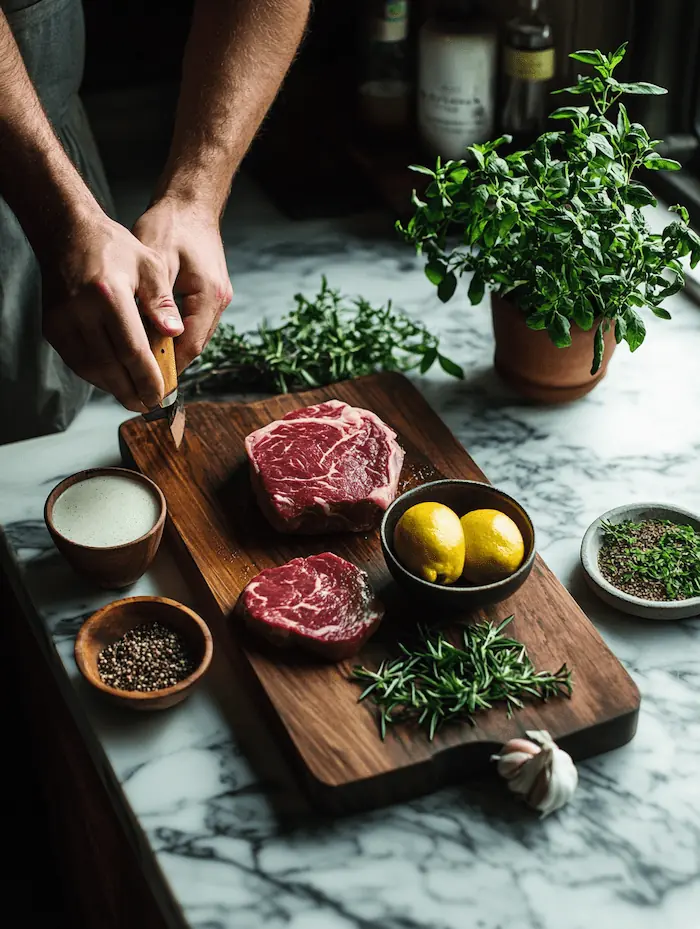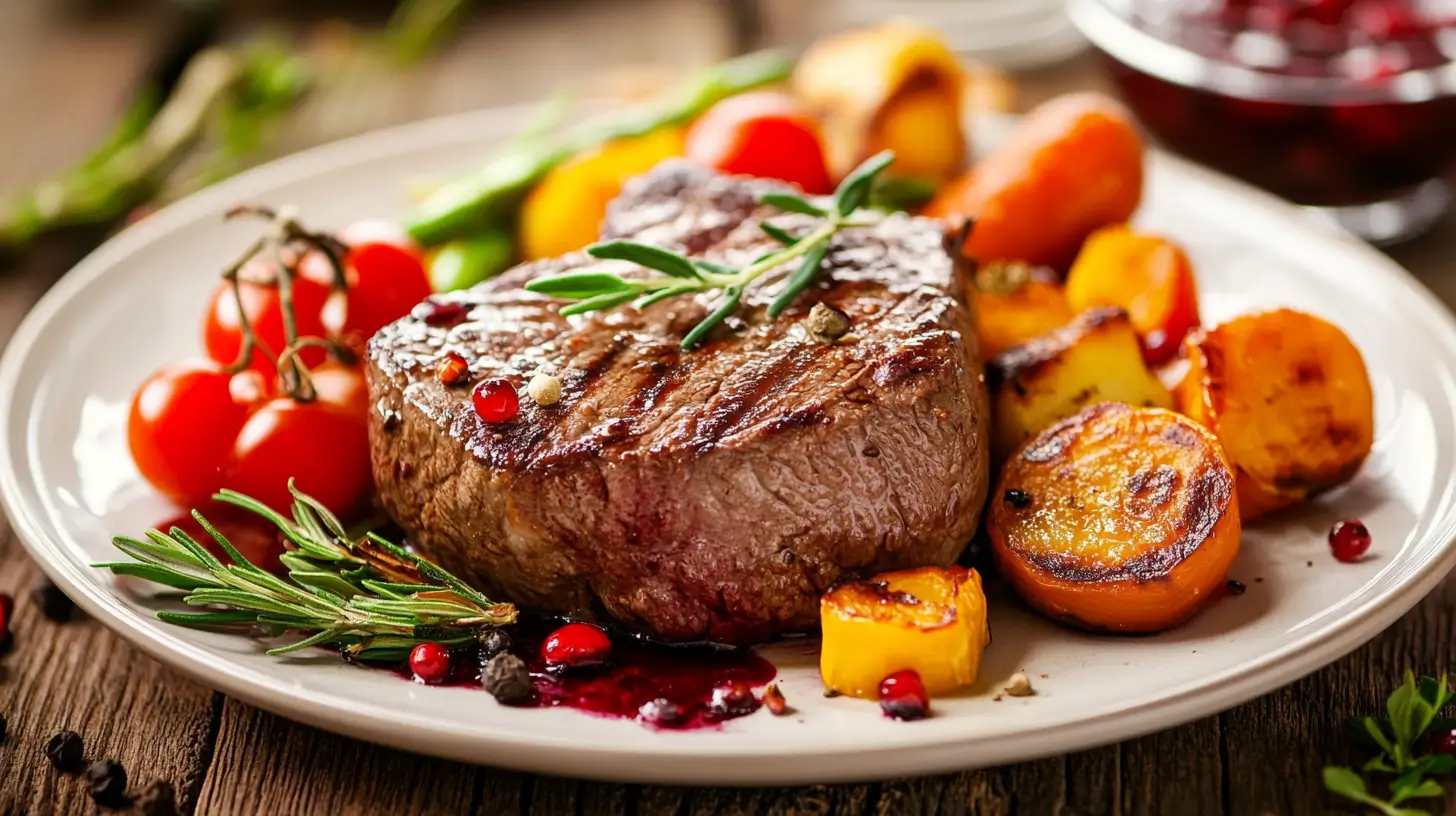Venison, the meat from deer, is prized for being lean, nutritious, and flavorful. However, its distinct gamey taste, caused by the animal’s diet, habitat, and meat processing, can be off-putting to some.
Fortunately, there are many ways to reduce or eliminate the gamey flavor, from soaking techniques to expert cooking methods. Whether you’re an experienced hunter or new to cooking game meat, understanding the reasons behind venison’s strong flavor and how to manage it will help you create delicious, crowd-pleasing dishes.
This article explores the science behind the gamey taste, offers practical tips to minimize it, and shows how to make venison a versatile favorite in your kitchen.
Table of contents
Understanding the Gamey Taste in Venison
To effectively reduce or eliminate the gamey taste in venison, it’s important to understand what causes it in the first place. This flavor, often described as earthy, musky, or even metallic, is unique to game meats and can vary in intensity depending on several factors.
Definition of “Gamey” Taste
The term “gamey” refers to a flavor that is distinctively different from farm-raised meats like beef, pork, or chicken. It’s often richer and more pronounced, which can be an acquired taste. For some, it’s the hallmark of wild meats, while others find it off-putting. The gamey taste in venison is influenced by the animal’s diet, age, and environment.
Environmental Factors
Deer are wild animals that forage for food in forests, fields, and meadows. Unlike domesticated livestock, their diet consists of natural vegetation such as grasses, berries, acorns, and even herbs. These foods can impart unique flavors to the meat. For instance:
- Diet: Deer that graze on acorns or other tannin-rich plants tend to have a stronger, more bitter flavor.
- Habitat: The region where the deer lives—whether it’s a dense forest or an open plain—affects the taste of its meat due to the diversity of its diet.
Processing and Handling
How venison is processed after a hunt plays a significant role in its flavor. Improper handling can intensify the gamey taste and lead to undesirable qualities. Key factors include:
- Field Dressing: The speed and efficiency of field dressing (removing the animal’s internal organs) can determine how clean the meat tastes. Delayed or poor field dressing can cause the meat to absorb unwanted odors and flavors.
- Cooling and Storage: Failing to cool the meat quickly or storing it improperly can lead to spoilage and enhance unpleasant flavors.
- Aging the Meat: While aging can tenderize venison, over-aging or poor aging techniques can amplify the gamey taste rather than mellow it.
By recognizing these factors, you can better control the flavor of venison before it even reaches your kitchen.
Methods to Remove the Gamey Taste
While venison’s gamey flavor can be appealing to some, many prefer a milder taste. Fortunately, several techniques can help minimize or even eliminate this distinct flavor, making venison more universally palatable.
Cooking with Strong Flavors
Incorporating bold spices or cooking venison in dishes like chili can mask the gamey taste. Try this venison chili recipe for a hearty meal.
Soaking Techniques
Soaking venison is one of the most effective ways to draw out the gamey flavor. The process helps remove excess blood and any residual compounds contributing to the musky taste.
Using Milk
Milk, especially whole milk, is a popular soaking medium. Its mild acidity and fat content work to neutralize strong flavors in the meat. Here’s how to use it:
- Place the venison in a container and fully submerge it in milk.
- Cover and refrigerate for 4-8 hours.
- Rinse the meat thoroughly before cooking.
Using Buttermilk
Buttermilk is even more effective due to its slightly tangy flavor and higher acidity. It not only mellows the gamey taste but also tenderizes the meat.
- Add a pinch of salt to the buttermilk for enhanced flavor absorption.
- Let the meat soak overnight for best results.
Using Vinegar or Acidic Solutions
Acidic ingredients like apple cider vinegar or lemon juice are excellent for breaking down gamey compounds in venison.
- Combine vinegar or lemon juice with water in a 1:4 ratio.
- Soak the venison for 1-2 hours. Be careful not to over-soak, as acids can toughen the meat.
Marinating Methods
Marinating venison infuses it with flavors while reducing the gamey taste. The key is to use marinades with strong, complementary flavors that mask the gaminess.
Best Marinades for Venison
- Red Wine-Based Marinades: Red wine, garlic, and rosemary create a robust flavor profile.
- Soy Sauce and Ginger Marinades: Soy sauce, ginger, and honey add a sweet-savory balance.
- Citrus Marinades: Orange or lime juice combined with herbs gives venison a refreshing zing.
How Long to Marinate
For maximum effectiveness:
- Marinate smaller cuts, like steaks, for 4-6 hours.
- Larger cuts, like roasts, can be marinated for up to 24 hours in the refrigerator.
Always cover the meat fully to ensure even absorption of flavors.
Spices and Seasoning Blends
Using the right spices and herbs can significantly enhance the flavor of venison, helping to mask its gaminess.
Spices That Mask Gamey Flavors
- Garlic and Onion Powder: Add depth and sweetness to the meat.
- Cumin and Coriander: Provide a smoky, earthy flavor.
- Paprika and Chili Powder: Add warmth and spice that complements venison.
Herb Combinations for Venison
- Rosemary and Thyme: Perfect for roasts and steaks.
- Parsley and Sage: Pair well with ground venison for burgers or stews.
- Mint and Basil: Fresh herbs add brightness to grilled or sautéed cuts.
By combining soaking, marinating, and seasoning techniques, you can effectively transform venison into a dish that appeals to a broader range of palates.

Cooking Techniques to Minimize Gamey Flavor
How you cook venison can greatly influence its flavor, especially when it comes to reducing the gamey taste. Proper cooking methods, temperatures, and ingredient pairings can make venison tender, juicy, and flavorful without being overpowering.
Slow Cooking
Slow cooking is an excellent way to mellow the strong flavors of venison. The extended cooking time allows the meat to absorb the flavors of seasonings, vegetables, and broths while breaking down tough fibers.
- Best Cuts for Slow Cooking: Shoulder, shank, and neck cuts.
- Flavor Additions: Use hearty ingredients like onions, carrots, celery, garlic, and beef stock to balance the flavors.
- Cooking Time: Simmer on low heat in a slow cooker or Dutch oven for 6-8 hours.
Pro Tip: Adding a splash of red wine or balsamic vinegar to the cooking liquid enhances the flavor and reduces gaminess.
Grilling
Grilling venison at high heat creates a delicious sear that locks in juices and masks gamey flavors.
- Preparation: Brush the meat with olive oil and season it generously with salt, pepper, and herbs.
- Cooking Time: Grill steaks or medallions for 2-3 minutes per side, depending on thickness, to achieve medium-rare doneness.
- Resting: Let the meat rest for 5-7 minutes after grilling to retain juices and improve flavor.
Pro Tip: Avoid overcooking venison, as it can become dry and intensify the gamey taste.
Smoking
Smoking imparts a rich, smoky flavor to venison, which pairs well with its natural earthiness.
- Wood Choice: Use mild woods like apple, cherry, or hickory for a balanced flavor.
- Preparation: Season the meat with a dry rub of garlic powder, paprika, and brown sugar.
- Cooking Time: Smoke venison at 200–225°F for 2-4 hours, depending on the cut.
Pro Tip: Basting the meat with a tangy barbecue sauce halfway through smoking can add sweetness and mask any lingering gamey notes.
Pairing with Sides
Choosing the right side dishes can help offset venison’s strong flavor and create a balanced meal.
- Vegetables: Roasted root vegetables like sweet potatoes, parsnips, and beets bring natural sweetness to the plate.
- Grains: Polenta, wild rice, or creamy mashed potatoes complement venison’s texture and flavor.
- Sauces: Berry-based sauces, such as cranberry or blackberry reduction, add a sweet-tart contrast to venison dishes.
Cooking Temperatures
Cooking venison to the correct internal temperature is critical for achieving the best flavor and texture:
- Steaks and Roasts: Medium-rare (130–135°F) is ideal. Overcooking can lead to a tougher texture and amplify the gamey taste.
- Ground Venison: Cook to 160°F to ensure safety while retaining moisture.
Using a meat thermometer ensures perfect results every time.
By mastering these cooking techniques and pairing venison with complementary flavors and sides, you can create dishes that are tender, flavorful, and free of overwhelming gaminess.
Preventing Gamey Flavor from the Start
Reducing the gamey taste of venison starts long before the meat reaches the kitchen. From proper hunting practices to choosing the right cuts of meat, these steps ensure venison with a milder and more enjoyable flavor.
Best Hunting Practices
How a deer is hunted and handled immediately after the kill can make a significant difference in its flavor.
- Shot Placement: A clean and humane shot is crucial to minimize stress, which can release adrenaline and lactic acid into the muscles, intensifying the gamey taste.
- Quick Field Dressing: Field dressing the deer as soon as possible helps remove internal organs and prevents the buildup of bacteria and odors.
- Cooling the Meat: Rapid cooling of the carcass is essential to preserve freshness and prevent gaminess. Ideally, the meat should be cooled to below 40°F within a few hours.
Proper Storage and Aging
Once the meat is harvested, correct storage and aging practices are vital.
- Storage: Keep the venison refrigerated or frozen promptly after butchering. Vacuum-sealing portions before freezing can prevent freezer burn and flavor loss.
- Aging: Dry-aging venison for 5–10 days in a controlled environment can improve tenderness and mellow the flavor. However, over-aging or improper temperature control can cause the meat to spoil or amplify undesirable flavors.
Selecting Quality Cuts
Not all cuts of venison are created equal when it comes to flavor. Some are naturally more tender and less gamey than others.
Choosing Tender Cuts
- Backstraps (Loin): This prized cut is tender and has a mild flavor, making it ideal for steaks and medallions.
- Tenderloin: Found inside the cavity, this is the most tender and least gamey cut.
Recognizing Aged Venison
Well-aged venison should have a deep red color with no strong odors. Avoid meat that appears brownish or smells overly metallic, as this could indicate poor processing or aging.
Processing Techniques
Professional processing can make a significant difference in the taste and texture of venison.
- Bone-In vs. Boneless: Processing venison without the bones can help avoid the metallic taste that sometimes comes from bone marrow.
- Grinding: For ground venison, mixing it with pork or beef fat creates a milder flavor and improves texture for burgers or sausages.
Avoiding Poor Practices
Certain habits can worsen the gamey taste of venison:
- Delayed Cleaning: Leaving the meat in the field too long can lead to contamination and stronger flavors.
- Improper Freezing: Freezing venison without proper packaging can cause freezer burn, which affects taste and texture.
By following these preventive measures, you can ensure venison that is flavorful, tender, and free of unnecessary gaminess from the very beginning.
Comparing Venison to Other Game Meats
Venison’s gamey taste often draws comparisons to other wild meats like elk, bison, and rabbit. Understanding these differences can help cooks choose the right meat for their recipes and expectations.
Gamey Flavor Differences
- Elk: Elk meat is less gamey than venison, with a milder, beef-like flavor and a slightly sweeter profile.
- Bison: Known for its lean yet tender texture, bison has a rich but not overly gamey taste.
- Rabbit: Rabbit meat is delicate and light, with a flavor similar to chicken but slightly earthy.
Venison’s unique flavor stands out because it combines richness with a lean texture, making it a versatile choice for both hearty and refined dishes.
Health Benefits of Venison
Venison isn’t just about flavor—it’s also a powerhouse of nutrition. Its health benefits make it an excellent choice for those seeking lean, high-quality protein.
Nutritional Advantages
- Low Fat Content: Venison is significantly leaner than beef or pork, with lower saturated fat levels.
- Rich in Protein: A single serving of venison provides ample protein for muscle repair and energy.
- Packed with Vitamins and Minerals: It’s an excellent source of iron, zinc, and B vitamins, particularly B12, which supports red blood cell production.
Lean Protein for Special Diets
Venison is ideal for:
- Keto and Low-Carb Diets: Its high protein and low carbohydrate content make it suitable for these dietary plans.
- Heart-Healthy Diets: Its low cholesterol and fat levels can support cardiovascular health.
Frequently Asked Questions
What does venison taste like?
Venison has a rich, earthy flavor that varies depending on the deer’s diet, habitat, and how it’s prepared. Proper cooking techniques can make it taste milder and more like beef.
Does freezing venison reduce gaminess?
Yes, freezing venison can slightly reduce its gamey taste, especially if it’s vacuum-sealed. However, long-term freezing without proper packaging may cause freezer burn, negatively affecting the flavor.
Can you eliminate the gamey taste completely?
While it’s difficult to remove all traces of gaminess, soaking, marinating, and proper cooking techniques can significantly mellow the flavor.
What’s the best marinade for venison?
A red wine marinade with garlic, rosemary, and olive oil works exceptionally well, as it complements the meat’s richness and masks gaminess.
Is venison healthier than beef?
Yes, venison is leaner and contains less saturated fat than beef, making it a healthier option for those looking to reduce fat intake while maintaining protein levels.
How do you store venison properly?
To preserve its flavor, venison should be vacuum-sealed and stored in the freezer at 0°F. Properly packaged venison can last up to a year in the freezer.
Conclusion
Venison is a flavorful, nutritious meat with a unique taste that can be adjusted to suit different palates. By understanding the factors that contribute to its gamey flavor and employing techniques like soaking, marinating, and proper cooking, you can transform venison into a dish that everyone will enjoy.
From field to fork, every step matters in ensuring the quality and taste of venison. Whether you’re slow-cooking a roast or grilling tenderloins, the right methods will bring out the best in this versatile meat. So, next time you’re preparing venison, try these tips to create a meal that’s both delicious and unforgettable.

